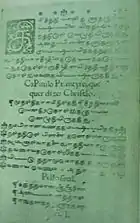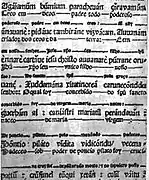Lingua Malabar Tamul or simply Malabar Tamil is a variant of Tamil language[1] promoted by European Missionaries in southern parts of Kerala state like Kollam and Thiruvananthapuram districts before they started promoting Malayalam language among newly converted Christians.[2] Malabar Tamil differs significantly from standard Tamil in its selection of vocabulary. Initially Malabar Tamil was printed using Roman script.[3] Later on, printing using Tamil script became widespread.[4]
Etymology
The word Malabar is derived from the words "mala-bar". Mala in Malayalam means "hill". Bar in Persian/Arabic means "country" or "nation".[5][6]
Gallery
 Doctrina Christam/Thambiran vanakkam (printed in 1578)
Doctrina Christam/Thambiran vanakkam (printed in 1578) Flos Santorum/Kirisithiani Vanakkam (printed in 1579)
Flos Santorum/Kirisithiani Vanakkam (printed in 1579) Cartilha, Germano Galhadro printed in Lisbon on 11 Feb 1554
Cartilha, Germano Galhadro printed in Lisbon on 11 Feb 1554
See also
References
- ↑ Xavier S. Thani Nayagam (1957). Tamil Culture. Academy of Tamil Culture. p. 246.
- ↑ S. Jeyaseela Stephen (1998). Portuguese in the Tamil coast: historical explorations in commerce and culture, 1507-1749. Navajothi Pub. House. pp. 328–329. ISBN 9788187382003.
- ↑ Stuart H. Blackburn (2006). Print, Folklore, and Nationalism in Colonial South India. Orient Blackswan. p. 33. ISBN 978-81-7824-149-4.
- ↑ Bellary Shamanna Kesavan (1984). History of Printing and Publishing in India: South Indian origins of printing. National Book Trust, India. p. 28.
- ↑ C. A. Innes and F. B. Evans, Malabar and Anjengo, volume 1, Madras District Gazetteers (Madras: Government Press, 1915), p. 2.
- ↑ M. T. Narayanan, Agrarian Relations in Late Medieval Malabar (New Delhi: Northern Book Centre, 2003), xvi-xvii.
This article is issued from Wikipedia. The text is licensed under Creative Commons - Attribution - Sharealike. Additional terms may apply for the media files.